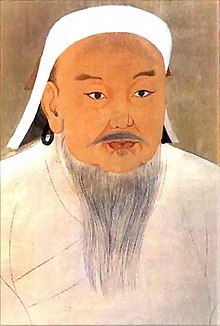
Back Mongole Afrikaans Mongolen ALS Pueblos mongols AN Mongolas ANG مغول Arabic مونجول ARZ Mongoles AST Monqollar Azerbaijani موغوللار AZB Монгол халыҡтары Bashkir
 Genghis Khan | |
| Total population | |
|---|---|
| 12 million | |
| Regions with significant populations | |
| Mongolia, China, Russia | |
| Languages | |
| Mongolic languages | |
| Religion | |
| Predominantly Tibetan Buddhism and Shamanism with minorities of Christianity, Islam, Atheism | |
| Related ethnic groups | |
| Khalkha, Daurs, Buryats, Evenks, Dorbots, Kalmyks, Oirats, Chakhars, Tumeds, Ordoses, Bayad, Dariganga, Urianhai, Uzemchin and Zakhchin. |
The name Mongols (Mongolian: Монгол Mongol) explains one or more ethnic groups. A hard definition includes the Mongols proper (self-designation Monggol), which can be split into eastern and western Mongols. In a bigger sense, the Mongol peoples also people who speak a Mongolic language but use other self-designations, such as the Kalmyks of eastern Europe.
The name Monggol has its meaning in the Tungusic languages and usually means "the invincible ones". At first it was applied to a small and still insignificant tribe in the area of the Onon river. In the 13th century it grew into an umbrella term for a large group of tribes united under the rule of Genghis Khan.